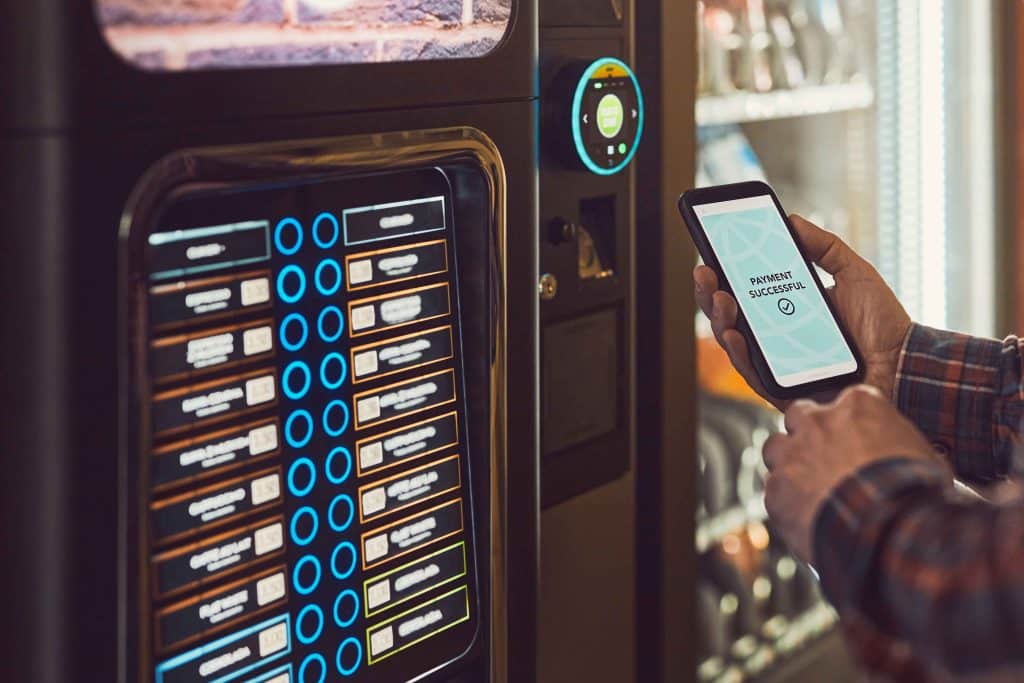The advent of mobile vending machines marks a transformative epoch in the retail and service sectors, underscoring an evolution from mere transactional devices to sophisticated, user-centric platforms that redefine convenience, accessibility, and interaction. These smart machines, empowered by cutting-edge technology, not only vend products but also offer a rich user experience (UX) that integrates digital advancements, personalized services, and intuitive design.
This comprehensive exploration delves into the multifaceted realm of UX design within the context of mobile vending machines, spotlighting the pivotal elements that contribute to creating an engaging, efficient, and inclusive customer journey.
Get Free Consultation
Key Takeaways
- Intuitive Design: The cornerstone of enhancing user interactions with mobile vending machines.
- Technology Integration: Smart features that enable seamless and personalized shopping experiences.
- Hygiene and Safety: Innovations catering to contemporary health concerns through touchless technology.
- Software Capabilities: The pivotal role of smart vending machine software in optimizing functionality.
- Market Adaptability: Strategies for the effective deployment of vending machines across various locations.
Evolution of Mobile Vending Machines
The progression from mechanical contraptions to digital powerhouses represents a significant leap in vending machine technology. Initially, vending machines were simple, coin-operated apparatuses with a basic mechanism to dispense a limited selection of items.
These machines underwent a revolutionary transformation, evolving into digital vending machines outfitted with touch screens, internet connectivity, and a myriad of payment options, thus vastly expanding their product offerings and user interaction capabilities.
Modern vending machines now boast smart technology, incorporating digital screens for advertising, interactive menus for easy navigation, and smart vending software that supports a variety of cashless transactions—ushering in an era where machines can offer personalized shopping experiences based on user preferences and past purchases.
From Mechanical to Digital
The journey from traditional coin-operated machines to digital vending machines showcases a dramatic transformation. Early vending machines were purely mechanical, offering a limited range of products. Today, smart vending machines, equipped with digital screens and touchless interfaces, offer a wide variety of items, from electronics to fresh food.
- Early Beginnings: Initially, vending machines were mechanical, offering limited selections. They required physical coins and manual selection.
- Digital Advancement: Modern iterations are digital vending machines equipped with touch screens, enabling a broader product range and interactive user interfaces.
Table: Comparison of Mechanical vs. Digital Vending Machines
| Feature | Mechanical Vending Machines | Digital Vending Machines |
| Payment | Coins only | Cashless options |
| Selection | Limited by physical space | Extensive, customizable |
| User Interaction | Minimal | Highly interactive |

Integration of Smart Technology
The infusion of smart technology into vending machines has catapulted them into the digital age, making them more than just points of sale; they are now interactive service platforms. Smart vending machines are equipped with features such as cashless payment systems, allowing for transactions via credit/debit cards, mobile wallets, and even cryptocurrency.
Moreover, these machines leverage IoT connectivity to provide services beyond mere vending, such as real-time inventory tracking, dynamic pricing, and targeted advertising based on demographic data and user interaction patterns.
The integration of smart vending software enables these machines to analyze purchasing trends, optimize stock levels, and even forecast future product demands, ensuring that they meet the consumers’ needs while also increasing operational efficiency.
The Advent of Specialized Solutions
The development of specialized vending solutions like the smart fridge vending machine illustrates the industry’s response to a broader range of consumer needs, including the demand for fresh, perishable goods.
These advanced machines are designed not only to store and vend items at optimal temperatures but also to incorporate advanced UX features that promote ease of use, such as clear glass displays for easy product viewing, interactive touch screens for detailed product information, and smart inventory systems that ensure the availability of fresh and high-quality items.
This focus on specialized solutions underscores the vending industry’s shift towards more versatile, user-friendly, and technologically advanced machines that cater to a wider variety of consumer preferences and dietary requirements.
Designing User-Centric Interfaces
In the domain of mobile vending machines, the design of user-centric interfaces plays a crucial role in enhancing the overall customer experience. Touch screen vending machines exemplify this focus on user experience, offering high-resolution displays that provide vibrant visuals and responsive touch controls for effortless navigation through product selections.
These interfaces are designed with intuitive user flow in mind, minimizing the number of steps required to complete a transaction and ensuring that information is presented clearly and concisely. Personalization emerges as a key aspect of the user experience, with smart vending machines utilizing data analytics to offer tailored recommendations and customizations.
By analyzing user preferences and purchase history, these machines can suggest products that meet individual tastes and dietary requirements, making each interaction feel personal and thoughtful.

Intuitive Touch Screen Controls
The touch screen vending machine stands out for its user-friendly interface, allowing customers to browse and select products with ease. This subsection will explore the design principles behind these screens, emphasizing simplicity and efficiency.
Touch Screen Vending Machines
- User Interface Design: Focuses on simplicity and efficiency, allowing users to easily browse and select products.
- Interactivity: Enhances customer engagement through features like product information, nutritional facts, and interactive promotions.
- Accessibility Features: Include voice navigation and adjustable height settings to accommodate all users.
Ensuring Accessibility and Inclusivity
A paramount aspect of UX design in mobile vending machines is ensuring accessibility and inclusivity, enabling all users, including those with disabilities, to engage with these devices effortlessly. Design considerations include the implementation of features such as audio instructions for users with visual impairments, tactile buttons and Braille labels for easy navigation, and adjustable screen heights to accommodate wheelchair users.
These inclusivity measures are not merely about compliance with legal standards but are a testament to the vending industry’s commitment to providing a seamless and equitable experience for every user. By embracing these principles, mobile vending machines can serve a broader demographic, reflecting a more inclusive approach to automated retail.
- Design Considerations: Implement features like audio commands, tactile buttons, and Braille labels for an inclusive user experience.
- Adaptive Interfaces: Screens that adjust content layout and size based on user needs.
- Compliance: Adhere to accessibility standards, ensuring vending machines are usable by everyone, including those with physical and sensory impairments.
Enhancing Engagement through Technology
The application of technology in mobile vending machines has significantly enhanced user engagement, transforming the purchasing process into an interactive and enjoyable experience. Innovative product discovery methods, such as augmented reality (AR) and virtual reality (VR), allow users to visualize products in 3D before making a purchase, providing a deeper understanding and connection with the item.
Read more about our Smart Vending Solutions!
This level of interactivity not only enriches the user experience but also fosters a stronger engagement with the product and brand. Furthermore, the integration of seamless payment solutions into mobile vending machines has revolutionized the transaction process, offering users a variety of secure and convenient payment options, including NFC, QR codes, and biometric verification.
This ease of payment, coupled with the implementation of smart vending machine software that manages inventory, processes payments, and provides valuable analytics, ensures that the machines are not just vending products but are offering a comprehensive and user-friendly service.

Interactive Product Discovery
Discovering products in a vending machine store becomes an interactive experience with augmented reality (AR) and virtual reality (VR) integrations. This subsection delves into how these technologies can be utilized to preview products in 3D before making a purchase, increasing engagement and satisfaction.
- AR and VR Integrations: Allow users to explore products in 3D before purchasing, providing a unique shopping experience.
- Digital Displays: Showcase product details, reviews, and usage tips to inform buying decisions.
- Engagement Tools: Incorporate social media features for sharing and recommendations.
The Role of Smart Vending Machine Software
Smart vending machine software is the backbone of a seamless user experience, managing inventory, facilitating payments, and providing real-time data analytics.
- Inventory Management: Automatically tracks stock levels, optimizes restocking schedules, and identifies popular items.
- User Analytics: Collects data on user preferences and purchase patterns to improve product offerings and marketing strategies.
- Maintenance Alerts: Sends real-time notifications for technical issues, ensuring minimal downtime.
Addressing Modern Needs with Smart Vending Solutions
In today’s world, where hygiene and safety have become paramount, touchless vending machines present a timely solution, minimizing physical contact and adhering to health guidelines. These machines employ advanced technologies such as gesture control, voice recognition, and smartphone integration to facilitate a touch-free interaction, thereby enhancing user confidence in using public vending services.
Additionally, the focus on sustainability within the vending industry reflects a commitment to environmental responsibility, with machines featuring energy-efficient designs, recyclable materials, and strategies to reduce waste. Customization and flexibility further underscore the adaptability of mobile vending machines, allowing for personalized product selections, aesthetic customizations to fit various environments, and dynamic software updates to meet changing consumer demands.
Touchless Vending for Health and Safety
In a post-pandemic world, hygiene and safety have become paramount. Touchless vending machines offer a sanitary way to purchase products, minimizing contact and the risk of transmission.
- Hygiene: Implement touchless technology like gesture control and voice commands to reduce physical contact.
- User Confidence: Enhance consumer trust in using vending machines, especially in high-traffic locations.
- Innovation: Continually evolve touchless features to meet emerging health and safety standards.
Customization and Flexibility
The ability to customize the product range and machine settings allows mobile vending machines to serve diverse needs. This part will examine the customization options available, from product selection to branding, offering flexibility to businesses and convenience to consumers.
- Modular Design: Allow for easy updates and modifications to product selections, machine aesthetics, and software features.
- Location Adaptability: Design machines to fit various environments, from corporate offices to outdoor parks.
- Branding Opportunities: Offer customizable panels and digital advertising space for brand promotions.
Conclusion
The journey of mobile vending machines from simple, coin-operated devices to sophisticated, smart platforms epitomizes the remarkable advancements in technology and user experience design within the retail sector.
These machines, now capable of offering personalized, engaging, and inclusive experiences, symbolize the future of automated retail—a future where technology and human-centered design converge to create seamless, efficient, and enjoyable purchasing journeys.
As the vending industry continues to innovate and adapt, the potential for further enhancements in UX design and technology promises to redefine convenience and interaction in the world of automated vending.
Frequently Asked Questions:
What is a smart vending machine?
A smart vending machine is equipped with advanced features like touch screens, internet connectivity, smart software, and various cashless payment options, offering a personalized and interactive shopping experience.
Can smart vending machines sell perishable items?
Yes, specially designed smart fridge vending machines can maintain perishable items at optimal temperatures, expanding the range of products that can be sold.
How do touchless vending machines enhance hygiene?
They use technology like gesture control and voice commands to minimize physical contact, addressing health and safety concerns.
Are mobile vending machines environmentally friendly?
Many are designed with sustainability in mind, using energy-efficient systems and recyclable materials to reduce environmental impact.
How do digital vending machines improve the user experience?
They provide interactive interfaces, personalized recommendations, extensive product information, and convenient payment options, making the purchasing process more engaging and user-friendly.
